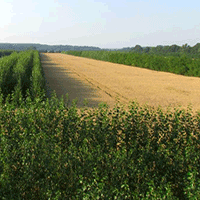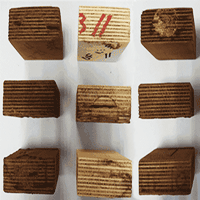
Soil nutrient status, nutrient return and retranslocation in poplar species and clones in northern Iran
Ali Salehi (1) , Neda Ghorbanzadeh (1), Maryam Salehi (2)
iForest - Biogeosciences and Forestry, Volume 6, Issue 6, Pages 336-341 (2013)
doi: https://doi.org/10.3832/ifor0976-006
Published: Aug 29, 2013 - Copyright © 2013 SISEF
Research Articles
Abstract
In this study several same-aged poplar species and clones were selected including Populus deltoides Marsh. CV. “Lux” (P.d “Lux”), Populus deltoides Marsh. CV. “Harvard” (P.d “Harvard”), Populus x canadensis Moench “Triplo” (P.xc “Triplo”), Populus x canadensis Moench “I-45/51” (P.xc “I-45/51”), planted in poplar research station about 20 years ago in the north of Iran, and Populus caspica Bornm. (P. caspica) as endemic and endangered poplar species. Some quantitative characteristics of the trees and soil samples were taken based on completely randomized block design. Samplings of live and senescent leaves were carried out in two-stages, mid-summer during the peak nutritional activities of trees and mid-autumn for senescent leaves. Soil samples were analyzed to determine organic carbon (OC), total nitrogen (N), available phosphorus (P) and exchangeable potassium (K). OC, total of N, P and K were also determined in live and senescent leaves. The results showed that P.d “Harvard” had the highest total height, DBH and diameter of crown compared to the other species and clones. The amount of OC, N and P in soil and live leaves of P.d “Harvard” clone are more than those of the other species and clones. OC, N, P, and K returned by senescent leaves were higher and lower for P.d “Harvard” and P. caspica respectively. P retranslocation for all of the clones and species was higher compared to N and K. The highest retranslocation percentage was observed in P. caspica (N=18.93, P=39.63, K=24.02) and the lowest (N=12.09, P=32.46, K=21.14) in P.d “Harvard” clone. It could be concluded that poplar species and clones have different nutritional requirements and retranslocation capabilities. It appears that P.d “Harvard” clone showed higher quantitative growth it could be beneficial for maintaining the soil nutrient status for successive plantings.
Keywords
Poplar, Retranslocation, Nutrient Return, Soil Properties, Plantation
Authors’ Info
Authors’ address
Neda Ghorbanzadeh
Department of Forestry, Natural Resources Faculty, University of Guilan, Guilan (Iran)
Department of Forestry, Natural Resources Faculty, University of Tehran, Tehran (Iran)
Corresponding author
Paper Info
Citation
Salehi A, Ghorbanzadeh N, Salehi M (2013). Soil nutrient status, nutrient return and retranslocation in poplar species and clones in northern Iran. iForest 6: 336-341. - doi: 10.3832/ifor0976-006
Academic Editor
Roberto Tognetti
Paper history
Received: Feb 18, 2013
Accepted: May 11, 2013
First online: Aug 29, 2013
Publication Date: Dec 02, 2013
Publication Time: 3.67 months
Copyright Information
© SISEF - The Italian Society of Silviculture and Forest Ecology 2013
Open Access
This article is distributed under the terms of the Creative Commons Attribution-Non Commercial 4.0 International (https://creativecommons.org/licenses/by-nc/4.0/), which permits unrestricted use, distribution, and reproduction in any medium, provided you give appropriate credit to the original author(s) and the source, provide a link to the Creative Commons license, and indicate if changes were made.
Web Metrics
Breakdown by View Type
Article Usage
Total Article Views: 58867
(from publication date up to now)
Breakdown by View Type
HTML Page Views: 48591
Abstract Page Views: 3587
PDF Downloads: 5306
Citation/Reference Downloads: 26
XML Downloads: 1357
Web Metrics
Days since publication: 4477
Overall contacts: 58867
Avg. contacts per week: 92.04
Citation Metrics
Article Citations
Article citations are based on data periodically collected from the Clarivate Web of Science web site
(last update: Mar 2025)
Total number of cites (since 2013): 3
Average cites per year: 0.23
Publication Metrics
by Dimensions ©
Articles citing this article
List of the papers citing this article based on CrossRef Cited-by.
References
Evaluation of different treatments in sexual reproduction of Populus caspica for broadening its genetic basis in the nature. Iranian Journal of Forest and Poplar Research 19: 441-452.
Gscholar
Factors influencing limit values for pine needle litter decomposition: a synthesis for boreal and temperate pine forest systems. Biogeochemistry 100: 57-73.
CrossRef | Gscholar
Plant species traits are the predominant control on litter decomposition rates within biomes worldwide. Ecology Letter 11: 1065-71.
CrossRef | Gscholar
Comparison of nutrient elements and elements retranslocation of Acer velutinum, Zelkova carpinifolia and Pinus brutia in Darabkola-Mazandaran. Iranian Journal of Forest 4: 175-185.
Gscholar
Nutrient distribution in Picea likiangensis trees growing in a plantation in West Sichuan, Southwest China. Silva Fennica 38: 235-242.
Gscholar
Plant association and edaphic features of a high arctic mesotopographic setting. Arctic and Alpin Reserch. 16: 11-24.
Gscholar
Fluxes of biogenic substances in precipitation and througfall in woodland ecosystems of the Slowinski National Park. Archives of Environmental Protection 34: 13-24.
Gscholar
The role of litter production and decomposition of dominant tree species on the nutrient cycle in natural forest with various substrate conditions, Doctoral dissertation, Hokkaido University, Sapporo, Japan, pp. 250.
Gscholar
Comparison of nutrition, nutrient return and nutrient retranslocation between stands of Alnus subcordata and Taxodium distichum in Tashbandan, Amol (Mazandaran). Journal of Wood & Forest Science and Technology 17: 65-78.
Gscholar

















